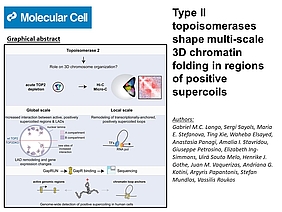New publication by the Roukos lab on how type II topoisomerases shape multi-scale 3D chromatin folding in regions of positive supercoils
Longo GMC, Sayols S, Stefanova ME, Xie T, Elsayed W, Panagi A, Stavridou AI, Petrosino G, Ing-Simmons E, Melo US, Gothe HJ, Vaquerizas JM, Kotini AG, Papantonis A, Mundlos S, Roukos V (2024) Type II topoisomerases shape multi-scale 3D chromatin folding in regions of positive supercoils. Mol Cell., doi: 10.1016/j.molcel.2024.10.007 Link
Abstract:
Type II topoisomerases (TOP2s) resolve torsional stress accumulated during various cellular processes and are enriched at chromatin loop anchors and topologically associated domain (TAD) boundaries, where, when trapped, can lead to genomic instability promoting the formation of oncogenic fusions. Whether TOP2s relieve topological constraints at these positions and/or participate in 3D chromosome folding remains unclear. Here, we combine 3D genomics, imaging, and GapRUN, a method for the genome-wide profiling of positive supercoiling, to assess the role of TOP2s in shaping chromosome organization in human cells. Acute TOP2 depletion led to the emergence of new, large-scale contacts at the boundaries between active, positively supercoiled, and lamina-associated domains. TOP2-dependent changes at the higher-order chromatin folding were accompanied by remodeling of chromatin-nuclear lamina interactions and of gene expression, while at the chromatin loop level, TOP2 depletion predominantly remodeled transcriptionally anchored, positively supercoiled loops. We propose that TOP2s act as a fine regulator of chromosome folding at multiple scales.
Read the full paper here: https://www.sciencedirect.com/science/article/pii/S109727652400830X?via%3Dihub

